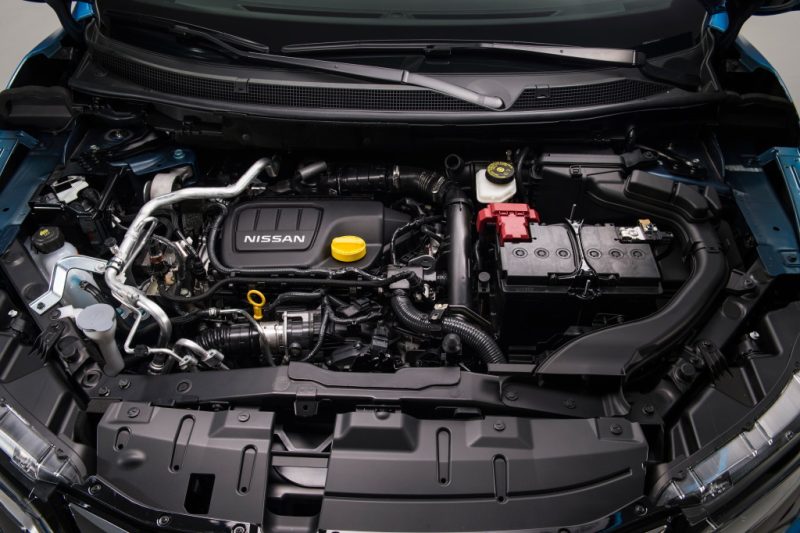The Nissan HRA2DDT, also known as the 1.2 DIG-T, is a 1.2-liter turbocharged four-cylinder gasoline engine with direct fuel injection. This motor was produced from 2013 to 2018 and was fitted to models such as the Nissan Juke, Pulsar and Qashqai. At the same time, Renault used a similar engine called 1.2 TCe with the H5Ft index.
Nissan HRA2DDT (1.2 DIG-T) specifications:
| Characteristics | Parameters |
|---|---|
| Motor label | HRA2DDDT |
| Engine type | Row, 4-cylinder |
| Operating volume | 1197 cm³ |
| Power | 115 hp (85 kW) at 4500 rpm |
| Torque | 190 Nm at 2000 rpm |
| Cylinder diameter | 72.2 mm |
| Piston stroke | 73.1 mm |
| Compression ratio | 10:1 |
| Environmental standard | Euro-5 / Euro-6 |
| Cylinder block material | Aluminum |
| Cylinder head material | Aluminum |
| Injection system | Direct injection (DIG) |
| Turbocharging | MHI TD02H2 |
| Transmission timing | Chain |
| Phase shifters | Inlet and exhaust |
| Hydrocompensators | No |
| Oil | 5W-30, 5W-40 |
| Oil volume | 4.6 liters |
| Engine weight | 110 kg |
| Fuel consumption (average) | 6.2 l/100 km |
| Engine life | About 200,000 km |
This engine was manufactured using lightweight materials: plasma sprayed aluminum cylinder block and aluminum block head.
Motor design and features

HRA2DDT is designed with a number of advanced technologies such as:
- Direct Fuel Injection: Provides precise fuel metering and injection directly into the cylinders for improved combustion efficiency.
- Low Inertia Turbine: The installed MHI TD02H2 turbine improves traction at low rpm, providing good dynamics in a small displacement.
- Phase shifters: Installed on the intake and exhaust shafts to help optimize engine performance at different RPMs.
This motor was characterized by high performance for its displacement and economy, but it was not without its drawbacks.
Main problems and disadvantages of the HRA2DDT engine
From the moment it was released on the market, owners of cars with HRA2DDT began to have complaints. Here are the most common problems:
- High oil consumption: The engine suffered from “oil consumption” already from the first kilometers of mileage. This was caused by poor quality piston rings. In some cases, faulty pistons led to damage to the cylinder walls, which required complete replacement of the block.
- Electronic problems: In the early years of production, the engine refused to start in cold weather. Dealers solved the problem by updating the ECU software.
- Transmission timing chain: Often stretched by the mileage of 100,000 km. There were also complaints about crunching of the timing chain.
- Valve fouling: Due to direct injection, fuel does not flush the intake valves, resulting in fouling buildup, deteriorating engine performance and reduced power.
- O-ring: The crankcase gas vent ring was bursting, resulting in leaks.
Maintenance
Regular maintenance is key to extending the life of the HRA2DDT engine. Maintenance recommendations include:
- Oil Change: Every 15,000 km or once a year, part number – 4.6 liters.
- Spark plug replacement: Every 30,000 km, part number – 2240100Q0G.
- Air filter: Every 30,000 km, part number 165464BA1A.
- Timing chain: 150,000 km, part number 1302800Q0J.
Life and reliability
The manufacturer declares the engine life about 200 000 km, but in practice this motor rarely withstands the mileage of more than 250 000 km. Problems with oil, timing chain and electronics require close attention of owners. However, with timely maintenance and regular oil changes, the engine can serve longer than the declared resource.
Is it a good engine?
Nissan HRA2DDT is an economical and quite productive engine for urban conditions, but its durability and reliability are questionable. For owners of cars with this motor, regular and quality maintenance is a necessity.
Engine Rating 3-
